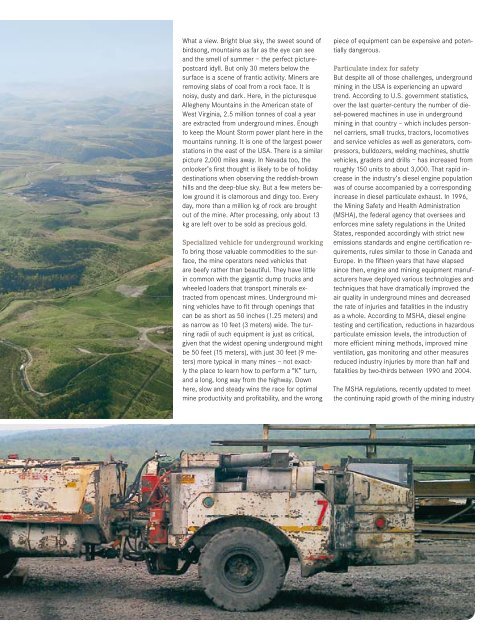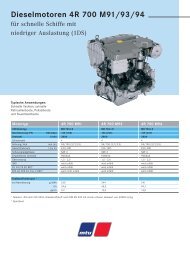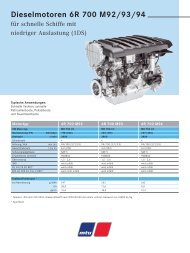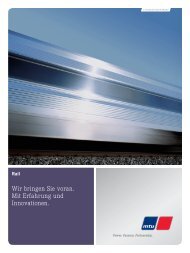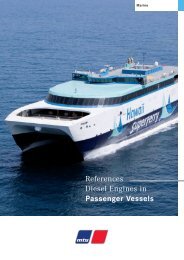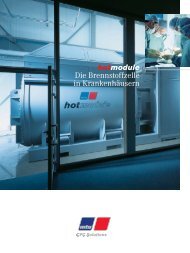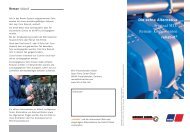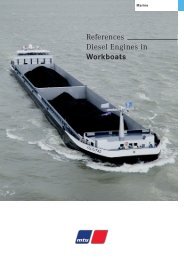You also want an ePaper? Increase the reach of your titles
YUMPU automatically turns print PDFs into web optimized ePapers that Google loves.
What a view. Bright blue sky, the sweet sound <strong>of</strong><br />
birdsong, mountains as far as the eye can see<br />
and the smell <strong>of</strong> summer – the perfect picturepostcard<br />
idyll. But only 30 meters below the<br />
surface is a scene <strong>of</strong> frantic activity. Miners are<br />
removing slabs <strong>of</strong> coal from a rock face. It is<br />
noisy, dusty and dark. Here, in the picturesque<br />
Allegheny Mountains in the American state <strong>of</strong><br />
West Virginia, 2.5 million tonnes <strong>of</strong> coal a year<br />
are extracted from underground mines. Enough<br />
to keep the Mount Storm power plant here in the<br />
mountains running. It is one <strong>of</strong> the largest power<br />
stations in the east <strong>of</strong> the USA. There is a similar<br />
picture 2,000 miles away. In Nevada too, the<br />
onlooker’s first thought is likely to be <strong>of</strong> holiday<br />
destinations when observing the reddish-brown<br />
hills and the deep-blue sky. But a few meters below<br />
ground it is clamorous and dingy too. Every<br />
day, more than a million kg <strong>of</strong> rock are brought<br />
out <strong>of</strong> the mine. After processing, only about 13<br />
kg are left over to be sold as precious gold.<br />
Specialized vehicle for underground working<br />
To bring those valuable commodities to the surface,<br />
the mine operators need vehicles that<br />
are beefy rather than beautiful. They have little<br />
in common with the gigantic dump trucks and<br />
wheeled loaders that transport minerals extracted<br />
from opencast mines. Underground mining<br />
vehicles have to fit through openings that<br />
can be as short as 50 inches (1.25 meters) and<br />
as narrow as 10 feet (3 meters) wide. The turning<br />
radii <strong>of</strong> such equipment is just as critical,<br />
given that the widest opening underground might<br />
be 50 feet (15 meters), with just 30 feet (9 meters)<br />
more typical in many mines – not exactly<br />
the place to learn how to perform a “K” turn,<br />
and a long, long way from the highway. Down<br />
here, slow and steady wins the race for optimal<br />
mine productivity and pr<strong>of</strong>itability, and the wrong<br />
piece <strong>of</strong> equipment can be expensive and potentially<br />
dangerous.<br />
Particulate index for safety<br />
But despite all <strong>of</strong> those challenges, underground<br />
mining in the USA is experiencing an upward<br />
trend. According to U.S. government statistics,<br />
over the last quarter-century the number <strong>of</strong> diesel-powered<br />
machines in use in underground<br />
mining in that country – which includes personnel<br />
carriers, small trucks, tractors, locomotives<br />
and service vehicles as well as generators, compressors,<br />
bulldozers, welding machines, shuttle<br />
vehicles, graders and drills – has increased from<br />
roughly 150 units to about 3,000. That rapid increase<br />
in the industry’s diesel engine population<br />
was <strong>of</strong> course accompanied by a corresponding<br />
increase in diesel particulate exhaust. In 1996,<br />
the Mining Safety and Health Administration<br />
(MSHA), the federal agency that oversees and<br />
enforces mine safety regulations in the United<br />
States, responded accordingly with strict new<br />
emissions standards and engine certification requirements,<br />
rules similar to those in Canada and<br />
Europe. In the fifteen years that have elapsed<br />
since then, engine and mining equipment manufacturers<br />
have deployed various technologies and<br />
techniques that have dramatically improved the<br />
air quality in underground mines and decreased<br />
the rate <strong>of</strong> injuries and fatalities in the industry<br />
as a whole. According to MSHA, diesel engine<br />
testing and certification, reductions in hazardous<br />
particulate emission levels, the introduction <strong>of</strong><br />
more efficient mining methods, improved mine<br />
ventilation, gas monitoring and other measures<br />
reduced industry injuries by more than half and<br />
fatalities by two-thirds between 1990 and 2004.<br />
The MSHA regulations, recently updated to meet<br />
the continuing rapid growth <strong>of</strong> the mining indus try


